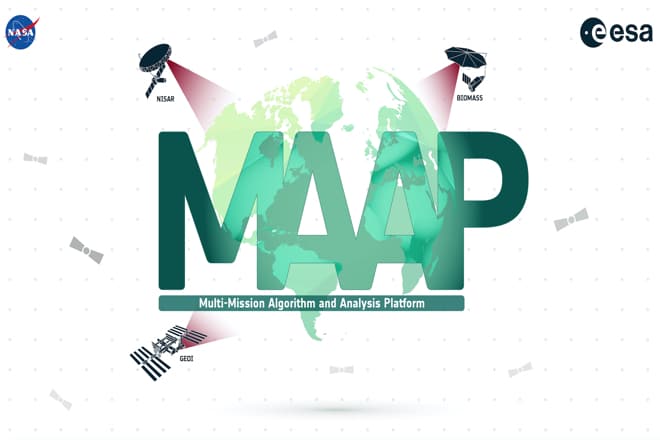NASA and ESA (European Space Agency) publicly released an open-source science tool for analysing Earth science data in the cloud – the Multi-Mission Algorithm and Analysis Platform (MAAP).
MAAP enables scientists to collaboratively develop algorithms and code as well as analyse and visualise large datasets acquired from sources including satellite instruments, the International Space Station, and airborne and ground campaigns. The large data and high-performance computing required for MAAP, along with a shared code repository and catalog, are stored and managed in the cloud. MAAP capabilities are supported and shared between NASA and ESA.
By following open-source science principles, including full and open access to data, the use of open-source code, and unrestricted access for data users, MAAP removes barriers to participation in scientific investigation, fosters greater diversity and inclusion, and enhances opportunities for discovery.
MAAP is said to provide access to NASA and ESA Earth science data and is a model for open-source science collaboration and analysis. As part of MAAP’s initial supported area of emphasis on aboveground biomass, it is the host platform for the first globally harmonised assessment of aboveground carbon – information that is vital for managing global climate change.
The partners said, MAAP is the culmination of a two-year NASA and ESA effort and reflects the cooperation between the two agencies under the NASA and ESA JPPG (Joint Program and Planning Group) Joint Working Group (WG) on Ground Segment and Operations. It is fully operational and will incrementally expand its user community over the coming months. The release of MAAP Version 2 in the Spring of 2022 will add additional data sources, allowing scientists to tackle a broader range of Earth science questions.
The initial application of MAAP focuses on measurements of aboveground biomass as part of a global effort to determine the size and carbon content of Earth’s forests. These data are critical for informing our understanding of climate change and forecasting its impacts and will be part of regular updates to the Intergovernmental Panel on Climate Change (IPCC). While biomass is the first application of MAAP, it easily can be adapted for collaborative exploration across the breadth of science data and scientific disciplines available through NASA, ESA, and similar research agencies.
MAAP currently includes data from missions such as NASA’s Global Ecosystem Dynamics Investigation (GEDI) and the joint NASA/ESA AfriSAR campaign and will eventually support data from upcoming NASA and ESA missions such as ESA’s Biomass mission and the joint NASA/Indian Space Research Organisation Synthetic Aperture Radar (NISAR) mission. A forthcoming connection to supercomputing facilities at NASA’s Ames Research Center in Silicon Valley, California, will enable efficient processing of extremely large MAAP global datasets, such as those expected from the NISAR mission.










































































